The Depositional Mechanism of Hydrothermal Chert Nodules in a Lacustrine Environment: A Case Study in the Middle Permian Lucaogou Formation, Junggar Basin, Northwest China
Abstract
:1. Introduction
2. Geological Background
3. Methods
3.1. Sample Pre-Treatment
3.2. Petrological Observation and Mineral Analysis
3.3. Major and Trace Elemental Analysis
4. Results
4.1. Petrology and Mineralogy
4.2. Elemental Compositions
4.2.1. Major and Trace Elements
4.2.2. Rare Earth Elements and Yttrium
5. Discussion
5.1. Origin of Chert Nodules
5.2. Recognition of Silicon Sources during Chert Precipitation
5.3. Depositional Model of Permian Chert Nodules in LCG Formation
6. Conclusions
Author Contributions
Funding
Acknowledgments
Conflicts of Interest
References
- Adachi, M.; Yamamoto, K.; Sugisaki, R. Hydrothermal chert and associated siliceous rocks from the northern Pacific their geological significance as indication od ocean ridge activity. Sediment. Geol. 1986, 47, 125–148. [Google Scholar] [CrossRef]
- Murchey, B.L.; Jones, D.L. A mid-Permian chert event: Widespread deposition of biogenic siliceous sediments in coastal, island arc and oceanic basins. Palaeogeogr. Palaeoclimatol. Palaeoecol. 1992, 96, 161–174. [Google Scholar] [CrossRef]
- Murray, R.W. Chemical criteria to identify the depositional environment of chert: General principles and applications. Sediment. Geol. 1994, 90, 213–232. [Google Scholar] [CrossRef]
- Shen, B.; Ma, H.R.; Ye, H.Q.; Lang, X.G.; Pei, H.X.; Zhou, C.M.; Zhang, S.H.; Yang, R.Y. Hydrothermal origin of syndepositional chert bands and nodules in the Mesoproterozoic Wumishan Formation: Implications for the evolution of Mesoproterozoic cratonic basin, North China. Precambrian Res. 2018, 310, 213–228. [Google Scholar] [CrossRef]
- Tatzel, M.; von Blanckenburg, F.; Oelze, M.; Schuessler, J.A.; Bohrmann, G. The silicon isotope record of early silica diagenesis. Earth Planet. Sci. Lett. 2015, 428, 293–303. [Google Scholar] [CrossRef] [Green Version]
- Yamamoto, K. Geochemical Characteristics and Depositional-Environments of Cherts and Associated Rocks in the Franciscan and Shimanto Terranes. Sediment. Geol. 1987, 52, 65–108. [Google Scholar] [CrossRef]
- Treguer, P.; Nelson, D.M.; Vanbennekom, A.J.; Demaster, D.J.; Leynaert, A.; Queguiner, B. The Silica Balance in the World Ocean—A Reestimate. Science 1995, 268, 375–379. [Google Scholar] [CrossRef]
- Crerar, D.; Anderson, G.J.C.G. Solubility and solvation reactions of quartz in dilute hydrothermal solutions. Chem. Geol. 1971, 8, 107–122. [Google Scholar] [CrossRef]
- Kuma, R.; Hasegawa, H.; Yamamoto, K.; Yoshida, H.; Whiteside, J.H.; Katsuta, N.; Ikeda, M. Biogenically induced bedded chert formation in the alkaline palaeo-lake of the Green River formation. Sci. Rep. 2019, 9, 16448. [Google Scholar] [CrossRef] [Green Version]
- Wells, N.A. Carbonate deposition, physical limnology and environmentally controlled chert formation in Paleocene-Eocene Lake Flagstaff, central Utah. Sediment. Geol. 1983, 35, 263–296. [Google Scholar] [CrossRef]
- Guo, P.; Li, C.; Wen, H.; Wei, Y.; Lei, H. Genesis of Continental Siliceous Rocks and Their Tectonic-climatic Significance. Acta Sedimentol. Sin. 2022, 40, 450–464. [Google Scholar] [CrossRef]
- Dong, Y.X.; Xu, S.L.; Wen, L.; Chen, H.D.; Fu, S.Y.; Zhong, Y.J.; Wang, J.Y.; Zhu, P.; Cui, Y. Tectonic control of Guadalupian-Lopingian cherts in northwestern Sichuan Basin, South China. Palaeogeogr. Palaeoclimatol. Palaeoecol. 2020, 557, 109915. [Google Scholar] [CrossRef]
- Lampropoulou, P.; Xanthopoulou, V.; Wojtaszek-Kalaitzidi, M.; Petrounias, P.; Zoumpouli, E.; Iliopoulos, G.; Kalaitzidis, S. Characterization of Siliceous Nodules in Western Kefalonia Ιsland Greece: An Initial Approach to Their Formation and Diagenetic Characteristics. Minerals 2022, 12, 101. [Google Scholar] [CrossRef]
- Shen, B.; Lee, C.T.A.; Xiao, S.H. Germanium/silica ratios in diagenetic chert nodules from the Ediacaran Doushantuo Formation, South China. Chem. Geol. 2011, 280, 323–335. [Google Scholar] [CrossRef]
- Renaut, R.; Jones, B.; Tiercelin, J.J. Rapid in situ silicification of microbes at Loburu hot springs, Lake Bogoria, Kenya Rift Valley. Sedimentology 1998, 45, 1083–1103. [Google Scholar] [CrossRef]
- Yao, X.; Li, S.; Zhou, Y.Q.; Hinnov, L.A. Hydrothermal Origin of Early Permian Chert Nodules in the Central North China Craton Linked to Northern Margin Cratonic Activation. Acta Geol. Sin-Engl. 2021, 95, 541–557. [Google Scholar] [CrossRef]
- Peterson, M.; Von der Borch, C. Chert: Modern inorganic deposition in a carbonate-precipitating locality. Science 1965, 149, 1501–1503. [Google Scholar] [CrossRef]
- White, A.H.; Youngs, B.C. Cambrian Alkali Playa-Lacustrine Sequence in the Northeastern Officer Basin, South-Australia. J. Sediment Petrol. 1980, 50, 1279–1286. [Google Scholar] [CrossRef]
- Qiu, Z.; Wang, Q. Geochemical evidence for submarine hydrothermal origin of the Middle-Upper Permian chert in Laibin of Guangxi, China. Sci. China Earth Sci. 2011, 54, 1011–1023. [Google Scholar] [CrossRef]
- Kato, Y.; Nakao, K.; Isozaki, Y. Geochemistry of Late Permian to Early Triassic pelagic cherts from southwest Japan: Implications for an oceanic redox change. Chem. Geol. 2002, 182, 15–34. [Google Scholar] [CrossRef]
- Sengupta, S.; Pack, A. Triple Oxygen Isotope Values of Cherts as a Proxy for the δ 18 O and Temperature Evolution of Seawater. In Proceedings of the AGU Fall Meeting Abstracts, Washington, DC, USA, 10–14 December 2018; p. V31B-06. [Google Scholar]
- Gao, P.; He, Z.L.; Lash, G.G.; Li, S.J.; Xiao, X.M.; Han, Y.Q.; Zhang, R.Q. Mixed seawater and hydrothermal sources of nodular chert in Middle Permian limestone on the eastern Paleo-Tethys margin (South China). Palaeogeogr. Palaeoclimatol. Palaeoecol. 2020, 551, 109740. [Google Scholar] [CrossRef]
- Zheng, H.F.; Wu, J.F.; Tang, H.L.; Liu, B.; Yang, X.Y.; Shi, K.B.; Luo, K.P.; Qiu, Q.; Dong, Y.X. Origin of the Multiple-Sourced Cherts in Maokou Carbonates in Sichuan Basin, South China. Minerals 2021, 11, 1269. [Google Scholar] [CrossRef]
- Yao, X.; Zhou, Y.; Li, S.; Li, D. Research status and advances in chert and Permian chert event. Adv. Earth Sci. 2013, 28, 1189–1200. [Google Scholar]
- Kamata, Y.; Maezawa, A.; Hara, H.; Ueno, K.; Hisada, K.; Sardsud, A.; Charoentitirat, T.; Charusiri, P. Basaltic activity preserved in an Upper Permian radiolarian chert from the Paleo-Tethys in the Inthanon Zone, northern Thailand. J. Asian Earth Sci. 2012, 61, 51–61. [Google Scholar] [CrossRef]
- Beauchamp, B.; Baud, A. Growth and demise of Permian biogenic chert along northwest Pangea: Evidence for end-Permian collapse of thermohaline circulation. Palaeogeogr. Palaeoclimatol. Palaeoecol. 2002, 184, 37–63. [Google Scholar] [CrossRef] [Green Version]
- Bohrmann, G.; Abelmann, A.; Gersonde, R.; Hubberten, H.; Kuhn, G. Pure Siliceous Ooze, a Diagenetic Environment for Early Chert Formation. Geology 1994, 22, 207–210. [Google Scholar] [CrossRef]
- Yu, K.H.; Zhang, Z.J.; Cao, Y.C.; Qiu, L.W.; Zhou, C.N.; Cheng, D.W.; Sun, P.P.; Yang, Y.Q. Origin of biogenic-induced cherts from Permian alkaline saline lake deposits in the NW Junggar Basin, NW China: Implications for hydrocarbon exploration. J. Asian Earth Sci. 2021, 211, 104712. [Google Scholar] [CrossRef]
- Yang, Y. A Preliminary Study on Exhalative Hydrothermal Deposits in the Lucaogou Formation in Jimusar Sag, Junggar Basin. Ph.D. Thesis, Northwestern University, Washington, DC, USA, 2014. [Google Scholar]
- Gao, Y.; Wang, G.; Li, N. Geochemical features and origin of siliceous rocks of the Permian Fengcheng Formation in the northwestern margin of Junggar Basin. J. Palaeogeog. Chin. 2019, 21, 647–660. [Google Scholar] [CrossRef]
- Wei, Y.; Guo, P.; Jing, J.; Jiang, Y.; Wang, J.; Lei, H.; Wen, H. Silexite genesis in volcanic-alkali lacustrine sedimentaryrocks: A case study of the lower Permian Fengcheng Formation, Junggar basin. Miner. Petrol. 2021, 41, 83–98. [Google Scholar] [CrossRef]
- Pe-Piper, G.; Piper, D.J.; Bourli, N.; Zelilidis, A. Evolution of Sedimentary Basins as Recorded in Silica Concretions: An Example from the Ionian Zone, Western Greece. Minerals 2021, 11, 763. [Google Scholar] [CrossRef]
- Meng, Z.; Liu, Y.; Jiao, X.; Ma, L.; Zhou, D.; Li, H.; Cao, Q.; Zhao, M.; Yang, Y. Petrological and organic geochemical characteristics of the Permian Lucaogou Formation in the Jimsar Sag, Junggar Basin, NW China: Implications on the relationship between hydrocarbon accumulation and volcanic-hydrothermal activities. J. Pet. Sci. Eng. 2022, 210, 110078. [Google Scholar] [CrossRef]
- Tao, H.F.; Qiu, Z.; Qu, Y.Q.; Liu, J.; Qin, Z.; Xie, Z.B.; Qiu, J.L.; Liu, B. Geochemistry of Middle Permian lacustrine shales in the Jimusar Sag, Junggar Basin, NW China: Implications for hydrothermal activity and organic matter enrichment. J. Asian Earth Sci. 2022, 232, 105267. [Google Scholar] [CrossRef]
- Wei, W.; Azmy, K.; Zhu, X.M. Impact of diagenesis on reservoir quality of the lacustrine mixed carbonate-siliciclastic-volcaniclastic rocks in China. J. Asian Earth Sci. 2022, 233, 105265. [Google Scholar] [CrossRef]
- Jiang, Y.Q.; Liu, Y.Q.; Yang, Z.; Nan, Y.; Wang, R.; Zhou, P.; Yang, Y.J.; Kou, J.Y.; Zhou, N.C. Characteristics and origin of tuff-type tight oil in Jimusaer sag, Junggar Basin, NW China. Petrol. Explor. Dev. 2015, 42, 810–818. [Google Scholar] [CrossRef]
- Zhang, C.; Liu, D.D.; Jiang, Z.X.; Song, Y.; Luo, Q.; Wang, X. Mechanism for the formation of natural fractures and their effects on shale oil accumulation in Junggar Basin, NW China. Int. J. Coal Geol. 2022, 254, 103973. [Google Scholar] [CrossRef]
- Wang, J.; Wu, C.; Zhou, T.; Zhu, W.; Zhou, Y.; Jiang, X.; Yang, D. Source-to-sink analysis of a transtensional rift basin from syn-rift to uplift stages. J. Sediment Res. 2019, 89, 335–352. [Google Scholar] [CrossRef] [Green Version]
- Allen, M.; Sengor, A.; Natal’In, B. Junggar, Turfan and Alakol basins as Late Permian to? Early Triassic extensional structures in a sinistral shear zone in the Altaid orogenic collage, Central Asia. J. Geol. Soc. London 1995, 152, 327–338. [Google Scholar] [CrossRef]
- Obrist-Farner, J.; Yang, W. Provenance and depositional conditions of fluvial conglomerates and sandstones and their controlling processes in a rift setting, mid-Permian lower and upper Quanzijie low order cycles, Bogda Mountains, NW China. J. Asian Earth Sci. 2017, 138, 317–340. [Google Scholar] [CrossRef]
- Yang, W.; Feng, Q.A.; Liu, Y.Q.; Tabor, N.; Miggins, D.; Crowley, J.L.; Lin, J.Y.; Thomas, S. Depositional environments and cyclo- and chronostratigraphy of uppermost Carboniferous-Lower Triassic fluvial-lacustrine deposits, southern Bogda Mountains, NW China—A terrestrial paleoclimatic record of mid-latitude NE Pangea. Glob. Planet. Chang. 2010, 73, 15–113. [Google Scholar] [CrossRef]
- Yang, W.; Liu, Y.Q.; Feng, Q.; Lin, J.Y.; Zhou, D.W.; Wang, D. Sedimentary evidence of Early-Late Permian mid-latitude continental climate variability, southern Bogda Mountains, NW China. Palaeogeogr. Palaeoclimatol. Palaeoecol. 2007, 252, 239–258. [Google Scholar] [CrossRef]
- Greene, T.J.; Carroll, A.R.; Wartes, M.; Graham, S.A.; Wooden, J.L. Integrated provenance analysis of a complex orogenic terrane: Mesozoic uplift of the Bogda Shan and inception of the Turpan-Hami Basin, NW China. J. Sediment Res. 2005, 75, 251–267. [Google Scholar] [CrossRef]
- Jun, G.; Maosong, L.; Xuchang, X.; Yaoqing, T.; Guoqi, H. Paleozoic tectonic evolution of the Tianshan Orogen, northwestern China. Tectonophysics 1998, 287, 213–231. [Google Scholar] [CrossRef]
- Han, B.F.; Guo, Z.J.; Zhang, Z.C.; Zhang, L.; Chen, J.F.; Song, B. Age, geochemistry, and tectonic implications of a late Paleozoic stitching pluton in the North Tian Shan suture zone, western China. Geol. Soc. Am. Bull. 2010, 122, 627–640. [Google Scholar] [CrossRef]
- Xiao, W.J.; Windley, B.F.; Allen, M.B.; Han, C.M. Paleozoic multiple accretionary and collisional tectonics of the Chinese Tianshan orogenic collage. Gondwana Res. 2013, 23, 1316–1341. [Google Scholar] [CrossRef]
- Wang, J.; Wu, C.; Li, Z.; Zhu, W.; Zhou, T.; Wu, J.; Wang, J. The tectonic evolution of the Bogda region from Late Carboniferous to Triassic time: Evidence from detrital zircon U–Pb geochronology and sandstone petrography. Geol. Mag. 2018, 155, 1063–1088. [Google Scholar] [CrossRef]
- Scotese, C.; Schettino, A. Late Permian-Early Jurassic paleogeography of western Tethys and the world. In Permo-Triassic Salt Provinces of Europe, North Africa and the Atlantic Margins; Elsevier: Amsterdam, The Netherlands, 2017; pp. 57–95. [Google Scholar] [CrossRef]
- Choulet, F.; Faure, M.; Cluzel, D.; Chen, Y.; Lin, W.; Wang, B. From oblique accretion to transpression in the evolution of the Altaid collage: New insights from West Junggar, northwestern China. Gondwana Res. 2012, 21, 530–547. [Google Scholar] [CrossRef] [Green Version]
- Buckman, S.; Aitchison, J.C. Tectonic evolution of Palaeozoic terranes in West Junggar, Xinjiang, NW China. Asp. Tecton. Evol. China 2004, 226, 101–129. [Google Scholar] [CrossRef]
- Liu, J.; Yi, J.; Chen, J.Y. Constraining assembly time of some blocks on eastern margin of Pangea using Permo-Triassic non-marine tetrapod records. Earth-Sci. Rev. 2020, 207, 103215. [Google Scholar] [CrossRef]
- Zhao, R.; Zhang, J.Y.; Zhou, C.M.; Zhang, Z.J.; Chen, S.; Stockli, D.F.; Olariu, C.; Steel, R.; Wang, H. Tectonic evolution of Tianshan-Bogda-Kelameili mountains, clastic wedge basin infill and chronostratigraphic divisions in the source-to-sink systems of Permian-Jurassic, southern Junggar Basin. Mar. Petrol. Geol. 2020, 114, 104200. [Google Scholar] [CrossRef]
- Gao, Y.; Huang, H.; Tao, H.F.; Carroll, A.R.; Qin, J.M.; Chen, J.Q.; Yuan, X.G.; Wang, C.S. Paleoenvironmental setting, mechanism and consequence of massive organic carbon burial in the Permian Junggar Basin, NW China. J. Asian Earth Sci. 2020, 194, 104222. [Google Scholar] [CrossRef]
- Ding, X.; Gao, C.; Zha, M.; Chen, H.; Su, Y. Depositional environment and factors controlling β-carotane accumulation: A case study from the Jimsar Sag, Junggar Basin, northwestern China. Palaeogeogr. Palaeoclimatol. Palaeoecol. 2017, 485, 833–842. [Google Scholar] [CrossRef]
- Wang, Y.; Chen, S.; Zhang, G.; Zhang, K.; Lin, H.; Liang, H.; Wang, Y.; Li, J. Classifications of mixosedimentite and sedimentary facies characteristics of mixed sedimentary facies belt in saline lacustrine basin: Taking examples as the Lucaogou Formation in the south of Junggar Basin and the Taerlang Formation in the northwest of Tuha Basin. Acta Petrolei. Sinica 2017, 38, 1021–1035,1065. [Google Scholar] [CrossRef]
- Carroll, A.R.; Graham, S.A.; Hendrix, M.S.; Ying, D.; Zhou, D. Late Paleozoic Tectonic Amalgamation of Northwestern China—Sedimentary Record of the Northern Tarim, Northwestern Turpan, and Southern Junggar Basins. Geol. Soc. Am. Bull. 1995, 107, 571–594. [Google Scholar] [CrossRef]
- Graham, S. Sedimentary record of Mesozoic deformation and inception of the Turpan-Hami basin, northwest China. Paleoz. Mesoz. Tecton. Evol. Cent. East. Asia 2001, 194, 317. [Google Scholar] [CrossRef] [Green Version]
- Huang, H.; Gao, Y.; Jones, M.M.; Tao, H.F.; Carroll, A.R.; Ibarra, D.E.; Wu, H.C.; Wang, C.S. Astronomical forcing of Middle Permian terrestrial climate recorded in a large paleolake in northwestern China. Palaeogeogr. Palaeoclimatol. Palaeoecol. 2020, 550, 109735. [Google Scholar] [CrossRef]
- Yang, Z.; He, S.; Li, Q.Y.; Lin, S.H.; Pan, S.Q. Geochemistry characteristics and significance of two petroleum systems near top overpressured surface in central Junggar Basin, NW China. Mar. Petrol. Geol. 2016, 75, 341–355. [Google Scholar] [CrossRef]
- Zhi, Y.; Zou, C.N.; Wu, S.T.; Lin, S.H.; Pan, S.Q.; Niu, X.B.; Men, G.T.; Tang, Z.X.; Li, G.H.; Zhao, J.H.; et al. Formation, distribution and resource potential of the “sweet areas (sections)” of continental shale oil in China. Mar. Petrol. Geol. 2019, 102, 48–60. [Google Scholar] [CrossRef]
- Yang, Y.; Qiu, L.; Wan, M.; Jia, X.; Cao, Y.; Lei, D.; Qu, C.S. Depositional model for a salinized lacustrine basin: The permian Lucaogou formation, Jimsar sag, Junggar Basin, NW China. J. Asian Earth Sci. 2019, 178, 81–95. [Google Scholar] [CrossRef]
- Cao, Z.; Liu, G.D.; Xiang, B.L.; Wang, P.; Niu, G.; Niu, Z.C.; Li, C.Z.; Wang, C.Y. Geochemical characteristics of crude oil from a tight oil reservoir in the Lucaogou Formation, Jimusar sag, Junggar Basin. Aapg Bull. 2017, 101, 39–72. [Google Scholar] [CrossRef]
- Cao, Z.; Liu, G.D.; Zhan, H.B.; Gao, J.; Zhang, J.Y.; Li, C.Z.; Xiang, B.L. Geological roles of the siltstones in tight oil play. Mar. Petrol. Geol. 2017, 83, 333–344. [Google Scholar] [CrossRef]
- Sun, F.N.; Hu, W.X.; Wang, X.L.; Cao, J.; Fu, B.; Wu, H.G.; Yang, S.C. Methanogen microfossils and methanogenesis in Permian lake deposits. Geology 2021, 49, 13–18. [Google Scholar] [CrossRef]
- Sun, F.N.; Hu, W.X.; Cao, J.; Wang, X.L.; Zhang, Z.R.; Ramezani, J.; Shen, S.Z. Sustained and intensified lacustrine methane cycling during Early Permian climate warming. Nat. Commun. 2022, 13, 4856. [Google Scholar] [CrossRef] [PubMed]
- Jin, J.; Wang, J.; Meng, Y.; Sun, P.C.; Liu, Z.J.; Li, Y.J.; Fang, S. Main Controlling Factors and Development Model of the Oil Shale Deposits in the Late Permian Lucaogou Formation, Junggar Basin (NW China). Acs. Earth Space Chem. 2022, 6, 1080–1094. [Google Scholar] [CrossRef]
- Liu, D.; Fan, Q.; Zhang, C.; Gao, Y.; Du, W.; Song, Y.; Zhang, Z.; Luo, Q.; Jiang, Z.; Huang, Z. Paleoenvironment evolution of the Permian Lucaogou Formation in the southern Junggar Basin, NW China. Palaeogeogr. Palaeoclimatol. Palaeoecol. 2022, 603, 111198. [Google Scholar] [CrossRef]
- Yang, Y.; Liu, Y.; Jiang, Y.; Yang, Z.; Zhou, D.; Jiao, X.; Zhou, P.; Li, X.; Jin, M. Geochemistry of the dolomitic rocks from the Permian Lucaogou Formation in the Jimusar depression, Junggar Basin, Xinjiang. Sediment. Geol. Tethyan Geol. 2019, 39, 84–93. [Google Scholar] [CrossRef]
- Liu, Y.; Zhou, D.; Jiao, X.; Feng, Q.; Zhou, X. A preliminary study on the relationship between deep-sourced materials and hydrocarbon generation in lacustrine source rocks: An example from the Permian black rock series in Jimusar sag, Junggar Basin. J. Palaeogeog. Chin. 2019, 21, 983–998. [Google Scholar] [CrossRef]
- Li, Z.; Liu, Y.; Jiao, X.; Zhou, D. Deep-derived clastics with porphyroclastic structure in lacustrine fine-grained sediments: Case study of the Permian Lucaogou Formation in Jimsar Sag, Junggar Basin. Nat. Gas Geosci. 2020, 31, 220–234. [Google Scholar] [CrossRef]
- Ma, J.; Wu, C.D.; Wang, Y.Z.; Wang, J.L.; Fang, Y.N.; Zhu, W.; Zhai, L.N.; Zhou, T.Q. Paleoenvironmental reconstruction of a saline lake in the Tertiary: Evidence from aragonite laminae in the northern Tibet Plateau. Sediment. Geol. 2017, 353, 1–12. [Google Scholar] [CrossRef]
- Larson, A.C.; Von Dreele, R.B. General Structure Analysis System (GSAS). Los Alamos National Laboratory Report LAUR 1994, 86–748. [Google Scholar]
- Mills, R.A.; Elderfield, H. Rare earth element geochemistry of hydrothermal deposits from the active TAG Mound, 26 N Mid-Atlantic Ridge. Geochim. Cosmochim. Acta 1995, 59, 3511–3524. [Google Scholar] [CrossRef]
- Alibo, D.S.; Nozaki, Y. Rare earth elements in seawater: Particle association, shale-normalization, and Ce oxidation. Geochim. Cosmochim. Acta 1999, 63, 363–372. [Google Scholar] [CrossRef]
- Krainer, K.; Spötl, C. Abiogenic silica layers within a fluvio-lacustrine succession, Bolzano Volcanic Complex, northern Italy: A Permian analogue for Magadi-type cherts? Sedimentology 1998, 45, 489–505. [Google Scholar] [CrossRef]
- Parnell, J. Devonian Magadi-Type Cherts in the Orcadian Basin, Scotland. J. Sediment Petrol. 1986, 56, 495–500. [Google Scholar] [CrossRef]
- Hedenquist, J.W.; Lowenstern, J.B. The Role of Magmas in the Formation of Hydrothermal Ore-Deposits. Nature 1994, 370, 519–527. [Google Scholar] [CrossRef]
- Paytan, A.; Mearon, S.; Cobb, K.; Kastner, M. Origin of marine barite deposits: Sr and S isotope characterization. Geology 2002, 30, 747–750. [Google Scholar] [CrossRef]
- Peters, T. Geochemistry of manganese-bearing cherts associated with Alpine ophiolites and the Hawasina formations in Oman. Mar. Geol. 1988, 84, 229–238. [Google Scholar] [CrossRef]
- Zabel, M.; Bickert, T.; Dittert, L. Significance of the sedimentary Al: Ti ratio as an indicator for variations in the circulation patterns of the equatorial North Atlantic. Paleoceanography 1999, 14, 789–799. [Google Scholar] [CrossRef] [Green Version]
- Zabel, M.; Schneider, R.R.; Wagner, T.; Adegbie, A.T.; de Vries, U.; Kolonic, S. Late Quaternary climate changes in central Africa as inferred from terrigenous input to the Niger fan. Quaternary Res. 2001, 56, 207–217. [Google Scholar] [CrossRef]
- Xing, C.C.; Liu, P.J.; Wang, R.M.; Li, C.Q.; Li, J.H.; Shen, B. Tracing the evolution of dissolved organic carbon (DOC) pool in the Ediacaran ocean by Germanium/silica (Ge/Si) ratios of diagenetic chert nodules from the Doushantuo Formation, South China. Precambrian Res. 2022, 374, 106639. [Google Scholar] [CrossRef]
- Cui, Y.X.; Lang, X.G.; Li, F.B.; Huang, K.J.; Ma, H.R.; Li, C.Q.; Pei, H.X.; Li, C.; Zhou, C.M.; Shen, B. Germanium/silica ratio and rare earth element composition of silica-filling in sheet cracks of the Doushantuo cap carbonates, South China: Constraining hydrothermal activity during the Marinoan snowball Earth glaciation. Precambrian Res. 2019, 332, 105407. [Google Scholar] [CrossRef]
- Thomas, R. Practical Guide to ICP-MS: A Tutorial for Beginners; CRC Press: Boca Raton, FL, USA, 2008. [Google Scholar]
- Smirnova, E.; Mysovskaya, I.; Lozhkin, V.; Sandimirova, G.; Pakhomova, N.; Smagunova, A. Spectral interferences from polyatomic barium ions in inductively coupled plasma mass spectrometry. J. Appl. Spectrosc. 2006, 73, 911–917. [Google Scholar] [CrossRef]
- Bolhar, R.; Van Kranendonk, M.J. A non-marine depositional setting for the northern Fortescue Group, Pilbara Craton, inferred from trace element geochemistry of stromatolitic carbonates. Precambrian Res. 2007, 155, 229–250. [Google Scholar] [CrossRef]
- Bau, M. Controls on the fractionation of isovalent trace elements in magmatic and aqueous systems: Evidence from Y/Ho, Zr/Hf, and lanthanide tetrad effect. Contrib. Miner. Petrol. 1996, 123, 323–333. [Google Scholar] [CrossRef]
- Tréguer, P.J.; De La Rocha, C.L. The world ocean silica cycle. Annu. Rev. Mar. Sci. 2013, 5, 477–501. [Google Scholar] [CrossRef] [PubMed]
- Urabe, T.; Kusakabe, M. Barite Silica Chimneys from the Sumisu Rift, Izu-Bonin Arc—Possible Analog to Hematitic Chert Associated with Kuroko Deposits. Earth Planet. Sci. Lett. 1990, 100, 283–290. [Google Scholar] [CrossRef]
- Bau, M.; Dulski, P. Comparing yttrium and rare earths in hydrothermal fluids from the Mid-Atlantic Ridge: Implications for Y and REE behaviour during near-vent mixing and for the Y/Ho ratio of Proterozoic seawater. Chem. Geol. 1999, 155, 77–90. [Google Scholar] [CrossRef]
- Gao, P.; He, Z.L.; Lash, G.G.; Li, S.J.; Zhang, R.Q. Origin of chert nodules in the Ediacaran Doushantuo Formation black shales from Yangtze Block, South China. Mar. Petrol. Geol. 2020, 114, 104227. [Google Scholar] [CrossRef]
- Murray, R.W.; Ten Brink, M.R.B.; Gerlach, D.C.; Russ, G.P., III; Jones, D.L. Rare earth, major, and trace elements in chert from the Franciscan Complex and Monterey Group, California: Assessing REE sources to fine-grained marine sediments. Geochim. Cosmochim. Acta 1991, 55, 1875–1895. [Google Scholar] [CrossRef]
- Bolhar, R.; Van Kranendonk, M.J.; Kamber, B.S. A trace element study of siderite-jasper banded iron formation in the 3.45 Ga Warrawoona Group, Pilbara Craton—Formation from hydrothermal fluids and shallow seawater. Precambrian Res. 2005, 137, 93–114. [Google Scholar] [CrossRef]
- Xu, J.; Shen, S.; Wang, Y.; Wang, F. New Evidence of Middle Permian Hydrothermal Cherts Deposition: A case study of Jitingling Breccia, south Anhui province. Acta Sedimentol. Sin. 2020, 38, 284–296. [Google Scholar] [CrossRef]
- Nozaki, Y.; Zhang, J.; Amakawa, H. The fractionation between Y and Ho in the marine environment. Earth Planet. Sci. Lett. 1997, 148, 329–340. [Google Scholar] [CrossRef]
- Douville, E.; Bienvenu, P.; Charlou, J.L.; Donval, J.P.; Fouquet, Y.; Appriou, P.; Gamo, T. Yttrium and rare earth elements in fluids from various deep-sea hydrothermal systems. Geochim. Cosmochim. Acta 1999, 63, 627–643. [Google Scholar] [CrossRef]
- Chen, D.Z.; Qing, H.R.; Yan, X.; Li, H. Hydrothermal venting and basin evolution (Devonian, South China): Constraints from rare earth element geochemistry of chert. Sediment. Geol. 2006, 183, 203–216. [Google Scholar] [CrossRef]
- Bau, M. Rare-Earth Element Mobility during Hydrothermal and Metamorphic Fluid Rock Interaction and the Significance of the Oxidation-State of Europium. Chem. Geol. 1991, 93, 219–230. [Google Scholar] [CrossRef]
- Rimstidt, J. Geothermal Mineralization I: The Mechanism of Formation of the Beowawe, Nevada Siliceous Sinter Deposit. Ph.D. Thesis, University of Utah, Salt Lake City, UT, USA, 1982. [Google Scholar] [CrossRef]
- Cai, Z.X.; Li, J.; Chen, H.R.; Cong, F.Y.; Wu, N.; Wang, L.J.; Wei, Q.C.; Luo, Y.P. Genesis of Mg-phyllosilicate occurrences in the Middle Permian marine successions of South China. Appl. Clay Sci. 2019, 181, 105242. [Google Scholar] [CrossRef]


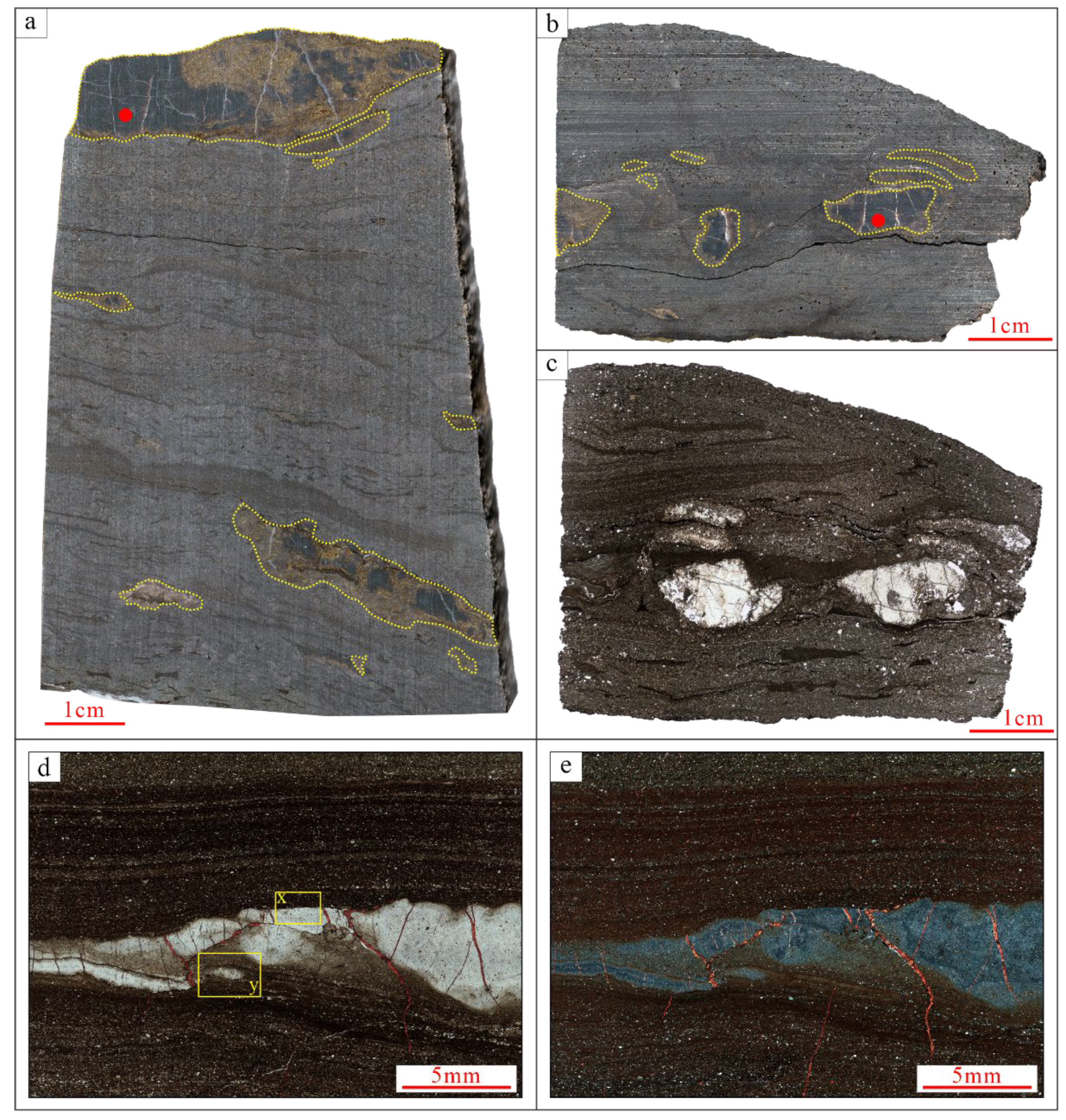
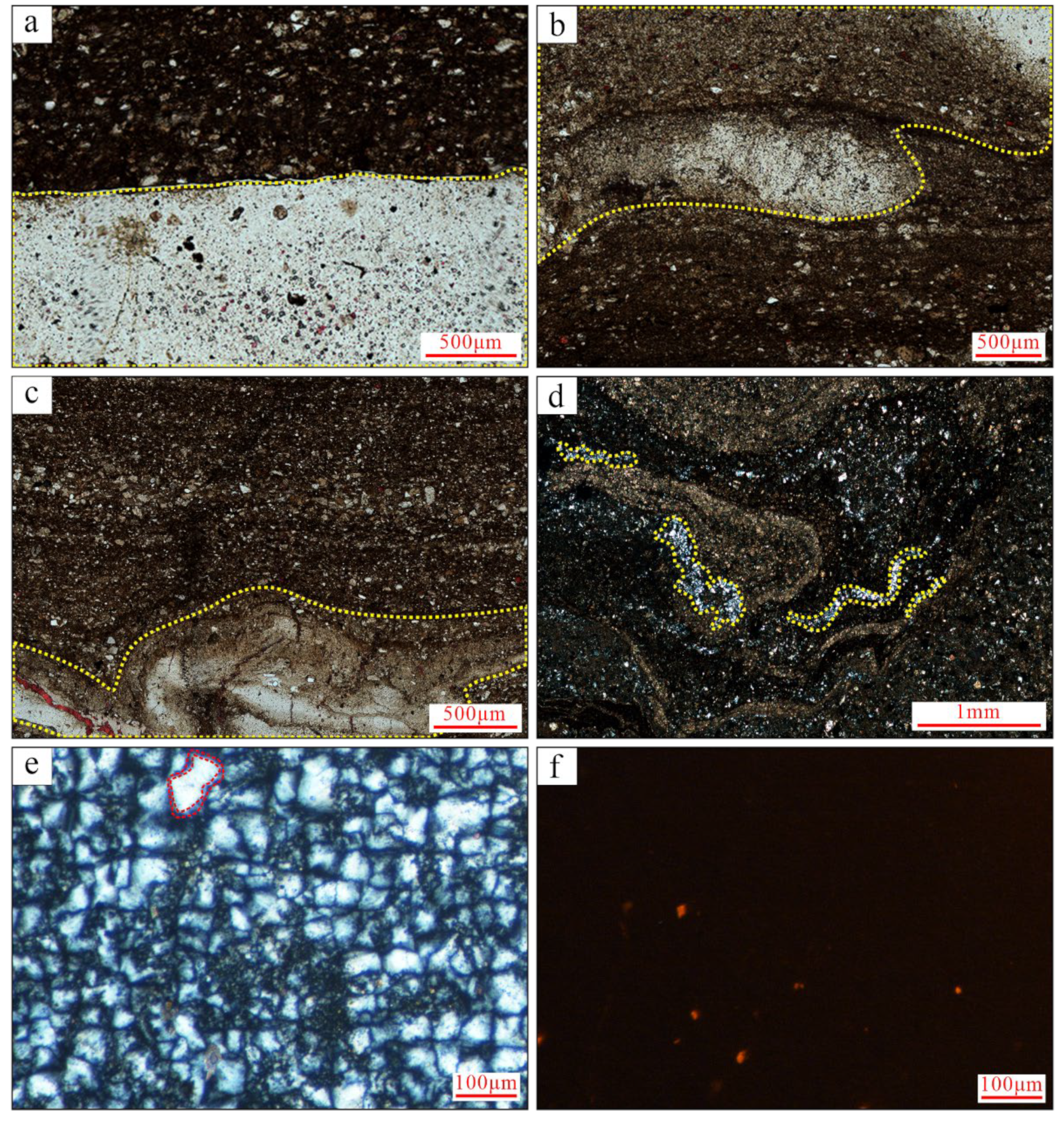
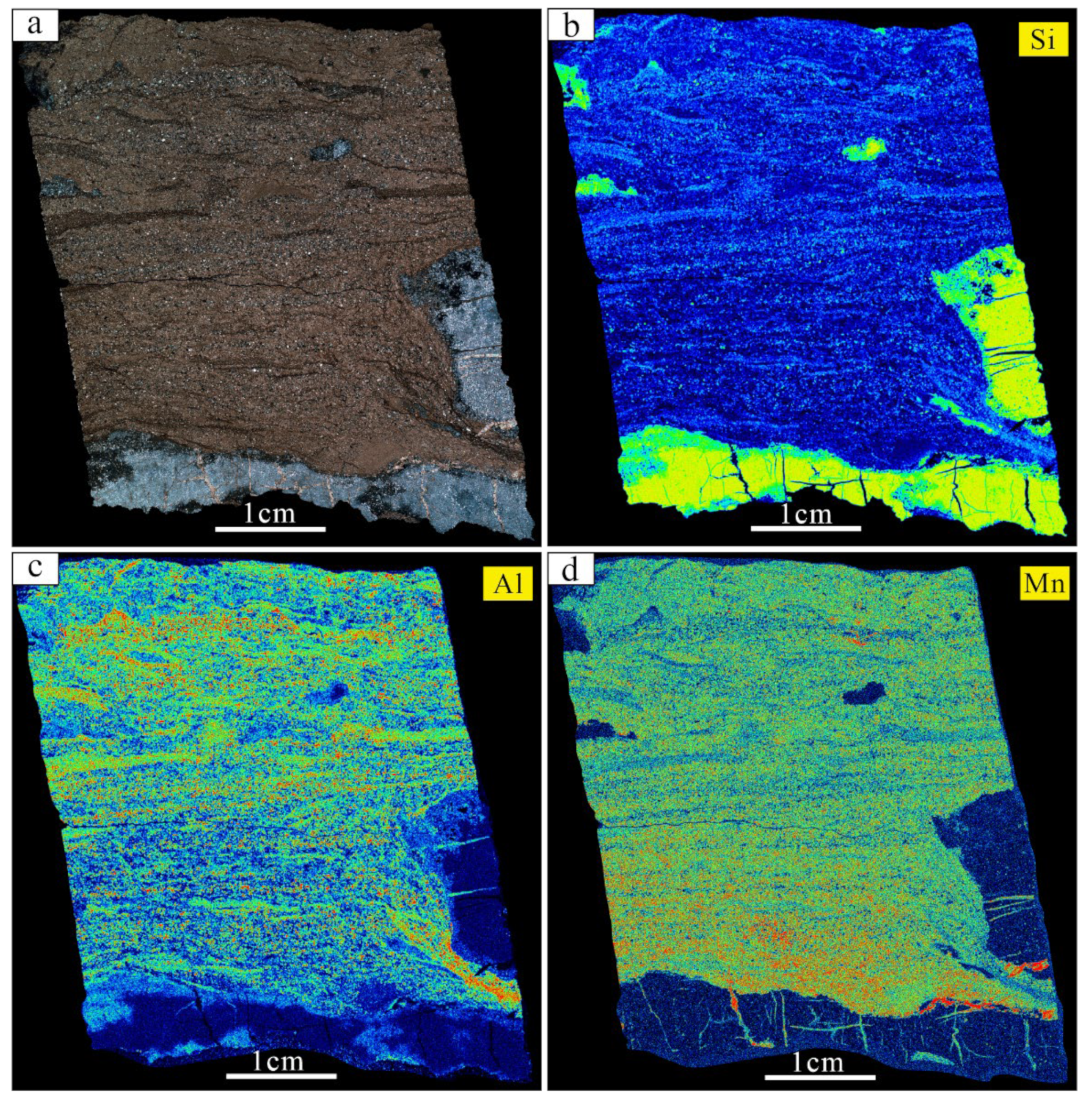
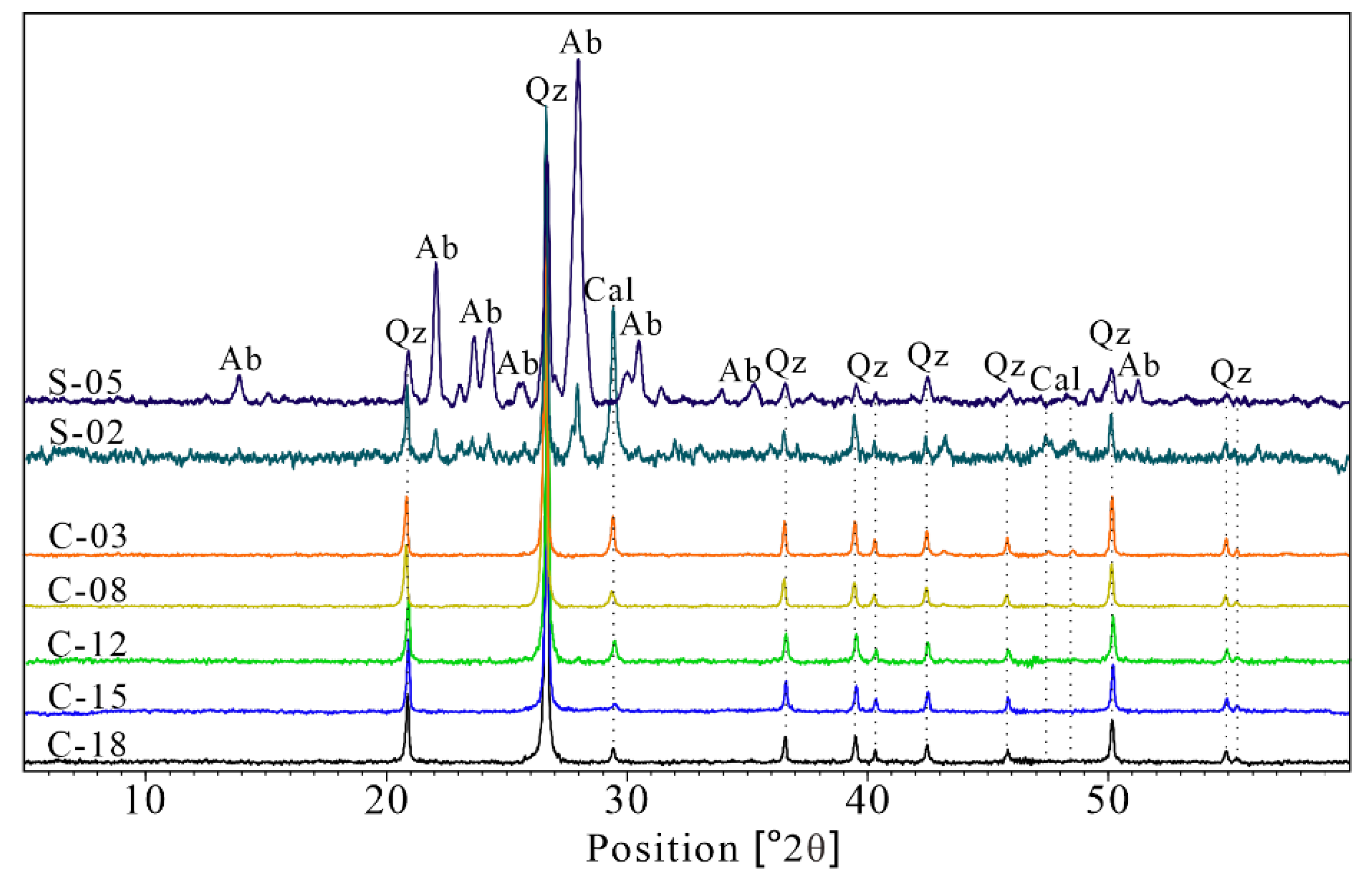


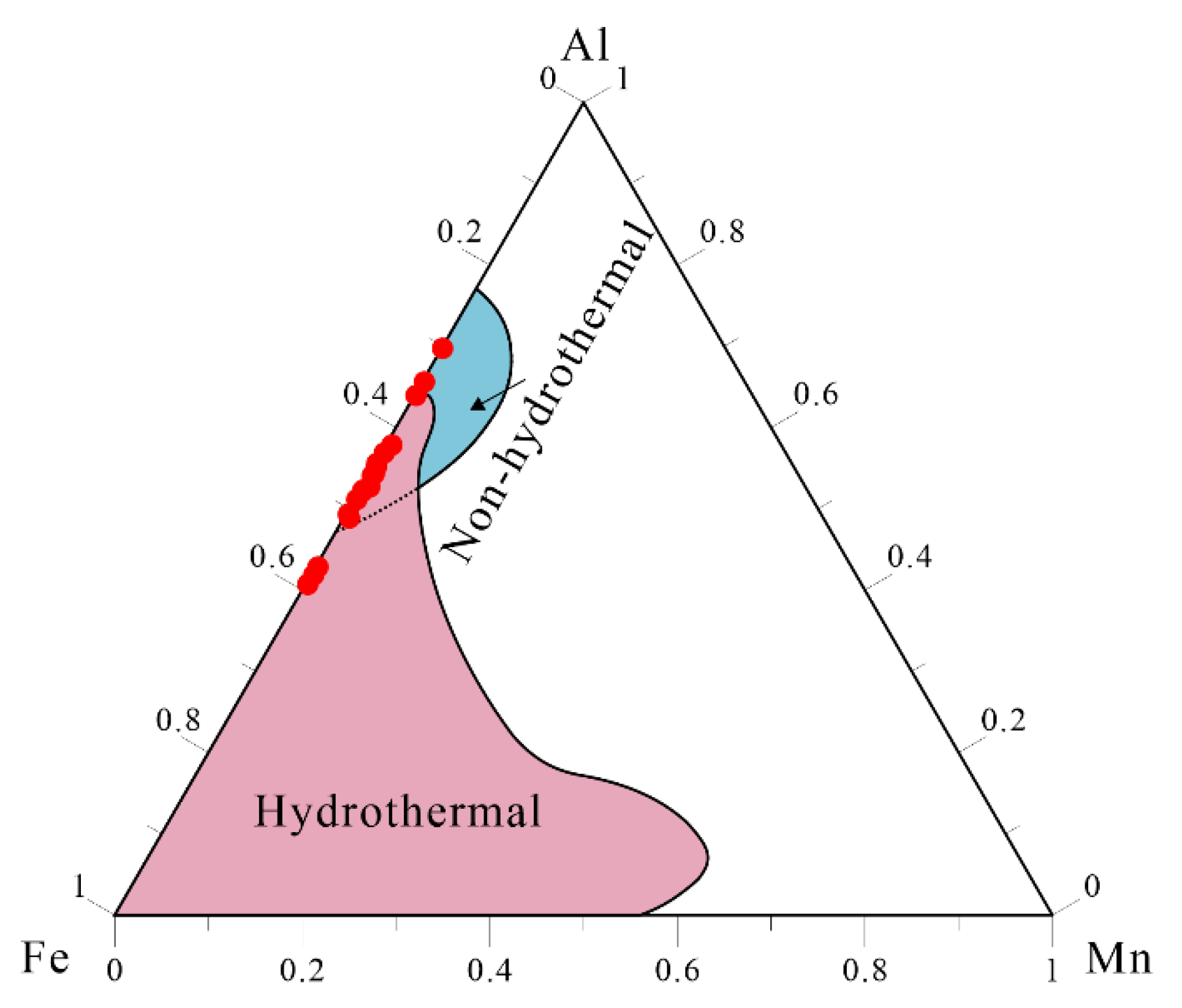
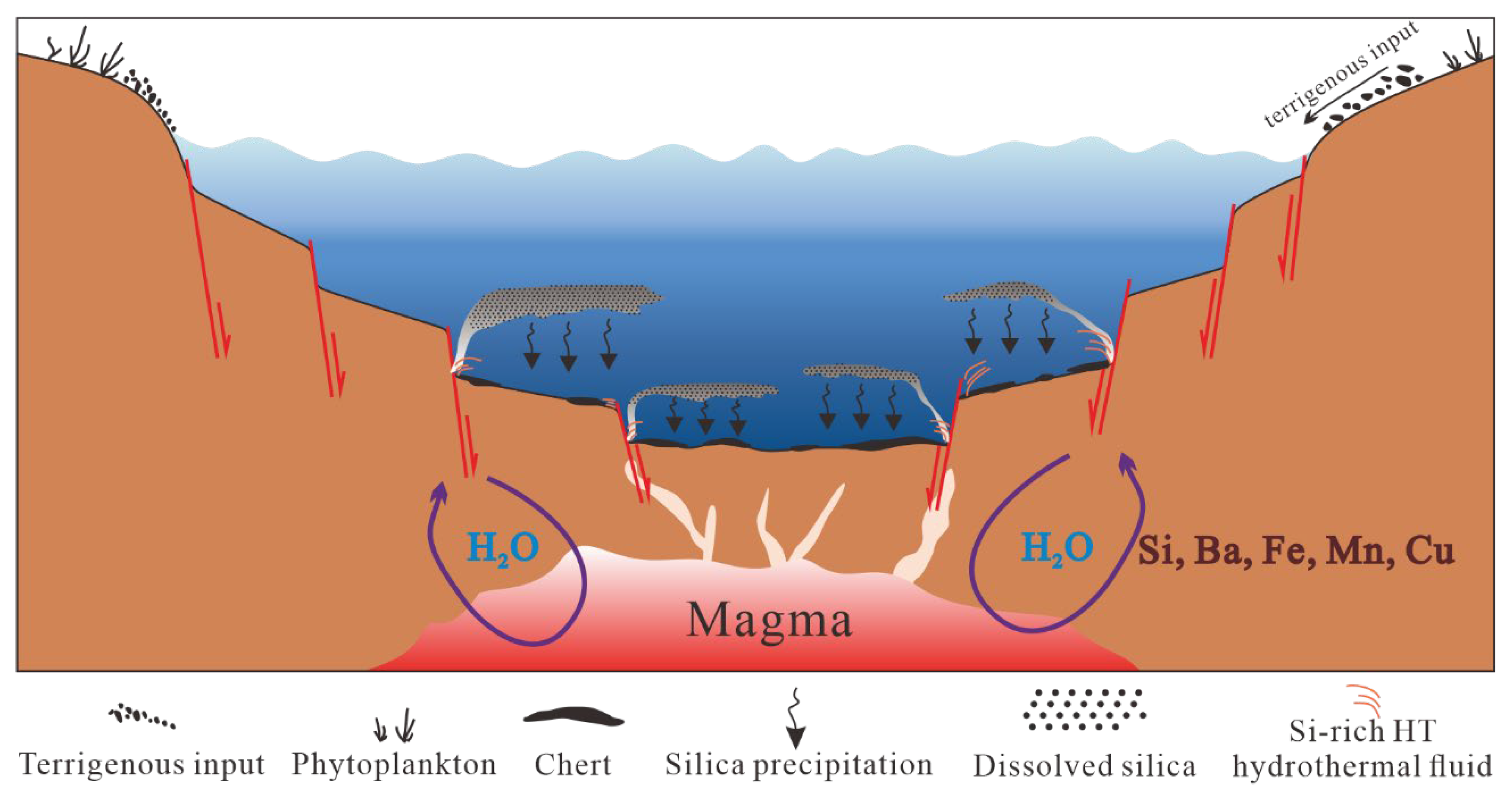

| Occurrence | Sample | SiO2 (wt.%) | Na2O (wt.%) | MgO (wt.%) | Al2O3 (wt.%) | P2O5 (wt.%) | K2O (wt.%) | CaO (wt.%) | TiO2 (wt.%) | TFe2O3 (wt.%) | LOI (wt.%) | Mn (ppm) | Ba (ppm) |
|---|---|---|---|---|---|---|---|---|---|---|---|---|---|
| chert nodules | C1 | 88.07 | 1.40 | 2.88 | 5.12 | 0.01 | 0.60 | 0.06 | 0.18 | 1.68 | - | 39.22 | 110.11 |
| C2 | 98.99 | 0.06 | 0.38 | 0.29 | 0.00 | 0.02 | 0.08 | 0.01 | 0.16 | - | 7.84 | 6.86 | |
| C3 | 97.71 | 0.06 | 1.10 | 0.61 | 0.00 | 0.02 | 0.02 | 0.01 | 0.47 | - | 8.99 | 10.70 | |
| C4 | 99.49 | 0.08 | 0.18 | 0.09 | 0.00 | 0.02 | 0.06 | 0.03 | 0.05 | - | 5.18 | 7.18 | |
| C5 | 99.12 | 0.13 | 0.22 | 0.30 | 0.00 | 0.05 | 0.04 | 0.03 | 0.12 | - | 5.29 | 15.11 | |
| C6 | 95.03 | 0.14 | 2.24 | 1.12 | 0.01 | 0.05 | 0.16 | 0.03 | 1.23 | - | 33.02 | 90.80 | |
| C7 | 95.69 | 0.53 | 0.92 | 1.74 | 0.01 | 0.22 | 0.06 | 0.09 | 0.74 | - | 20.95 | 95.44 | |
| C8 | 95.81 | 0.18 | 1.21 | 1.22 | 0.01 | 0.16 | 0.15 | 0.04 | 1.23 | - | 32.01 | 27.68 | |
| C9 | 97.48 | 0.18 | 0.49 | 0.88 | 0.01 | 0.16 | 0.17 | 0.04 | 0.59 | - | 66.91 | 37.10 | |
| C10 | 90.61 | 0.53 | 2.50 | 3.40 | 0.01 | 0.64 | 0.13 | 0.11 | 2.05 | - | 65.85 | 63.62 | |
| C11 | 95.01 | 0.46 | 1.66 | 1.59 | 0.01 | 0.18 | 0.05 | 0.09 | 0.96 | - | 24.94 | 80.18 | |
| C12 | 92.21 | 0.11 | 4.27 | 1.63 | 0.00 | 0.05 | 0.01 | 0.02 | 1.69 | - | 27.21 | 13.46 | |
| C13 | 99.10 | 0.08 | 0.36 | 0.22 | 0.01 | 0.03 | 0.04 | 0.02 | 0.13 | - | 7.49 | 8.29 | |
| C14 | 98.99 | 0.11 | 0.45 | 0.18 | 0.00 | 0.03 | 0.06 | 0.03 | 0.14 | - | 8.59 | 9.45 | |
| C15 | 86.60 | 0.75 | 5.95 | 3.66 | 0.02 | 0.25 | 0.08 | 0.10 | 2.60 | - | 47.15 | 49.63 | |
| C16 | 92.22 | 0.50 | 2.58 | 2.47 | 0.01 | 0.36 | 0.04 | 0.12 | 1.69 | - | 47.14 | 64.64 | |
| C17 | 97.21 | 0.20 | 0.72 | 0.92 | 0.01 | 0.19 | 0.12 | 0.05 | 0.58 | - | 22.73 | 32.20 | |
| C18 | 78.69 | 0.15 | 10.68 | 5.79 | 0.00 | 0.74 | 0.01 | 0.02 | 3.92 | - | 105.85 | 295.13 | |
| Average | 94.33 | 0.31 | 2.16 | 1.74 | 0.01 | 0.21 | 0.08 | 0.06 | 1.11 | - | 32.02 | 56.53 | |
| surrounding rocks | S1 | 35.25 | 3.64 | 6.57 | 11.35 | 0.18 | 1.42 | 15.76 | 0.38 | 5.86 | 19.60 | 1609.71 | 1144.33 |
| S2 | 39.28 | 2.79 | 5.15 | 8.61 | 1.94 | 1.27 | 17.37 | 0.32 | 3.95 | 19.31 | 1181.82 | 1332.84 | |
| S3 | 53.18 | 4.15 | 5.24 | 13.05 | 0.20 | 2.32 | 6.01 | 0.47 | 4.89 | 10.49 | 513.63 | 568.66 | |
| S4 | 26.99 | 2.30 | 2.78 | 5.97 | 0.10 | 0.76 | 31.10 | 0.24 | 2.27 | 27.49 | 2141.52 | 488.99 | |
| S5 | 71.79 | 7.99 | 0.10 | 17.03 | 0.01 | 2.21 | 0.03 | 0.38 | 0.33 | 0.13 | 15.58 | 119.16 | |
| S6 | 71.22 | 8.33 | 0.14 | 16.99 | 0.01 | 2.25 | 0.03 | 0.47 | 0.37 | 0.17 | 21.35 | 110.85 | |
| S7 | 58.58 | 10.53 | 0.56 | 23.94 | 0.03 | 3.28 | 0.04 | 0.62 | 1.75 | 0.65 | 73.37 | 171.93 | |
| Average | 50.90 | 5.68 | 2.94 | 13.85 | 0.35 | 1.93 | 10.05 | 0.41 | 2.78 | 11.12 | 793.85 | 562.39 |
| Sample | C3 | C5 | C8 | C10 | C12 | C14 | C15 | C18 | S2 | S5 |
|---|---|---|---|---|---|---|---|---|---|---|
| La (ppm) | 0.38 | 0.14 | 0.05 | 0.05 | 1.65 | 1.28 | 1.14 | 1.82 | 21.85 | 28.96 |
| Ce (ppm) | 0.99 | 0.32 | 0.13 | 0.15 | 3.75 | 3.29 | 2.41 | 3.32 | 55.54 | 77.79 |
| Pr (ppm) | 0.12 | 0.04 | 0.02 | 0.02 | 0.42 | 0.41 | 0.28 | 0.35 | 5.84 | 8.17 |
| Nd (ppm) | 0.50 | 0.16 | 0.07 | 0.08 | 1.72 | 1.70 | 1.12 | 1.35 | 22.27 | 30.76 |
| Sm (ppm) | 0.17 | 0.04 | 0.02 | 0.02 | 0.40 | 0.47 | 0.28 | 0.22 | 3.99 | 5.35 |
| Eu (ppm) | 0.13 | 0.02 | 0.01 | 0.01 | 0.13 | 0.28 | 0.12 | 0.10 | 0.75 | 0.99 |
| Gd (ppm) | 0.22 | 0.07 | 0.03 | 0.04 | 0.50 | 0.73 | 0.33 | 0.25 | 3.68 | 4.87 |
| Tb (ppm) | 0.05 | 0.02 | 0.01 | 0.01 | 0.10 | 0.22 | 0.07 | 0.04 | 0.49 | 0.67 |
| Dy (ppm) | 0.41 | 0.14 | 0.06 | 0.09 | 0.75 | 2.04 | 0.57 | 0.27 | 3.10 | 4.35 |
| Ho (ppm) | 0.10 | 0.03 | 0.02 | 0.03 | 0.17 | 0.57 | 0.14 | 0.06 | 0.66 | 0.93 |
| Er (ppm) | 0.32 | 0.11 | 0.06 | 0.10 | 0.54 | 1.93 | 0.46 | 0.20 | 2.23 | 3.13 |
| Tm (ppm) | 0.06 | 0.02 | 0.01 | 0.02 | 0.08 | 0.28 | 0.07 | 0.03 | 0.34 | 0.48 |
| Yb (ppm) | 0.44 | 0.11 | 0.08 | 0.12 | 0.53 | 1.58 | 0.50 | 0.21 | 2.36 | 3.36 |
| Lu (ppm) | 0.07 | 0.02 | 0.01 | 0.02 | 0.08 | 0.21 | 0.08 | 0.03 | 0.37 | 0.52 |
| Y (ppm) | 2.46 | 0.88 | 0.46 | 0.65 | 4.24 | 13.62 | 3.29 | 1.54 | 17.31 | 24.06 |
| ∑REE (ppm) | 3.97 | 1.24 | 0.57 | 0.76 | 10.84 | 15.00 | 7.58 | 8.26 | 123.46 | 170.32 |
| LaN/YbN | 0.06 | 0.09 | 0.05 | 0.03 | 0.23 | 0.06 | 0.17 | 0.64 | 0.68 | 0.64 |
| Y/Ho | 25.10 | 25.19 | 28.60 | 24.86 | 24.58 | 23.86 | 23.98 | 25.81 | 26.23 | 25.89 |
| Eu* | 3.15 | 2.00 | 2.69 | 2.00 | 1.35 | 2.16 | 1.82 | 1.97 | 0.92 | 0.91 |
| Ce* | 1.06 | 1.04 | 1.05 | 1.16 | 1.03 | 1.03 | 0.98 | 0.95 | 1.13 | 1.16 |
Publisher’s Note: MDPI stays neutral with regard to jurisdictional claims in published maps and institutional affiliations. |
© 2022 by the authors. Licensee MDPI, Basel, Switzerland. This article is an open access article distributed under the terms and conditions of the Creative Commons Attribution (CC BY) license (https://creativecommons.org/licenses/by/4.0/).
Share and Cite
Zhou, J.; Yang, H.; Liu, H.; Jiao, Y. The Depositional Mechanism of Hydrothermal Chert Nodules in a Lacustrine Environment: A Case Study in the Middle Permian Lucaogou Formation, Junggar Basin, Northwest China. Minerals 2022, 12, 1333. https://doi.org/10.3390/min12101333
Zhou J, Yang H, Liu H, Jiao Y. The Depositional Mechanism of Hydrothermal Chert Nodules in a Lacustrine Environment: A Case Study in the Middle Permian Lucaogou Formation, Junggar Basin, Northwest China. Minerals. 2022; 12(10):1333. https://doi.org/10.3390/min12101333
Chicago/Turabian StyleZhou, Jiaquan, Hailin Yang, Hanlin Liu, and Yue Jiao. 2022. "The Depositional Mechanism of Hydrothermal Chert Nodules in a Lacustrine Environment: A Case Study in the Middle Permian Lucaogou Formation, Junggar Basin, Northwest China" Minerals 12, no. 10: 1333. https://doi.org/10.3390/min12101333





